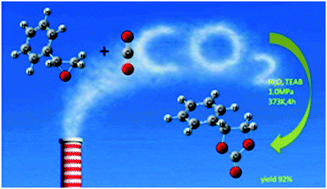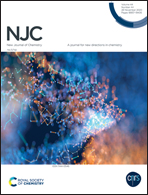Molecular design and experimental study on synergistic catalysts for the synthesis of cyclocarbonate from styrene oxide and CO2†
Abstract
Taking the reaction between styrene oxide and CO2 to yield cyclocarbonate as the target, the activities of synergistic catalysts, which are composed of Br− and alcohol compounds serving as hydrogen bond donors (HBDs), were predicted by DFT calculations and confirmed by subsequent experiments. Intramolecular reactions of the active intermediate as well as intermolecular reactions between the active intermediate and styrene oxide were possible side reactions. DFT calculation results show that the most likely by-product is phenylacetone, which is produced from the intramolecular reaction of the active intermediate. According to the calculation results, the catalytic activity of a synergistic catalyst is related to the pKa of the HBD, and the optimal calculated pKa is about 3–4 fold higher than the pKa of 2-bromo-1-phenylethanol, which is the protonated active intermediate of the target reaction. The combination of water and tetraethylammonium bromide (TEAB) was found to be a promising synergistic catalyst, and it can give a conversion of 50% and a yield of 43% under the conditions of 1% (mol%) catalyst loading, solvent free, 100 °C, 1.0 MPa and 1 h. Additionally, the TEAB can be reused. The observed catalytic activity of water is higher than expected but similar to that of styrene glycol, which is the hydration product of styrene oxide. Water is therefore an indirect catalyst and the catalytic activity is mainly contributed by the styrene glycol.



 Please wait while we load your content...
Please wait while we load your content...